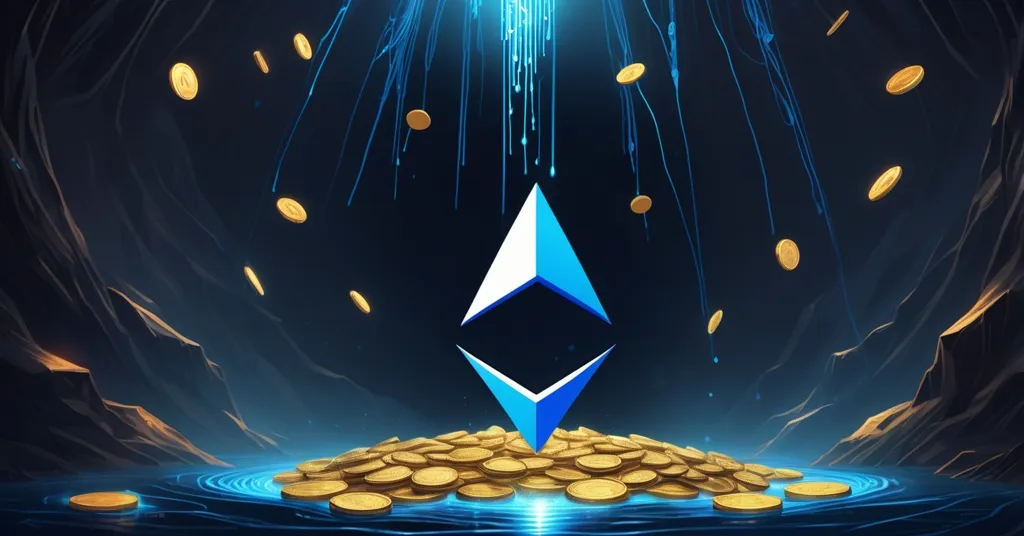Ethereum ETFs Hit $668M Inflows: Is DeFi Newcomer Mutuum Finance a Hidden Gem or Hype Trap?

Ethereum ETFs Soar with $668M Inflows: Is DeFi Star Mutuum Finance the Next Big Crypto Investment?
Ethereum is basking in institutional glory with a massive $668 million in net inflows to its exchange-traded funds (ETFs) in October 2025, while a lesser-known DeFi project, Mutuum Finance (MUTM), is turning heads with bold promises of explosive returns. Is Ethereum’s steady climb the safe path forward, or does a scrappy upstart like Mutuum Finance hold the key to outsized gains in the wild world of crypto?
- Ethereum ETF Surge: $668M net inflows in October 2025, pushing total assets to $25B with $55.25B in trading volume, a clear sign of institutional trust.
- Mutuum Finance Presale Buzz: $18.4M raised from 17,700 investors, token price up 250% to $0.035, with a potential 420% gain at launch.
- Critical Lens: Can MUTM’s untested DeFi model outshine Ethereum’s proven ecosystem, or is this just presale hype with no substance?
Ethereum’s ETF Triumph: A Stamp of Institutional Confidence
The numbers don’t lie—Ethereum ETFs pulled in a staggering $668 million in net inflows during October 2025, one of the strongest performances since their inception. This has ballooned their total assets under management to $25 billion, with trading volumes hitting an eye-watering $55.25 billion, the second-highest on record. For context, that’s a volume figure that rivals even some Bitcoin ETF metrics for the same period, hinting at a seismic shift in how traditional finance views altcoins beyond the king, Bitcoin. At a current price of $3,880—edging up 0.8% in the last 24 hours—Ethereum is no longer the volatile wild card it once was a decade ago. It’s a matured asset, a cornerstone of decentralized finance (DeFi) and smart contract innovation that’s earning its stripes on Wall Street.
For those new to the game, ETFs are a bridge for traditional investors to dip their toes into crypto without directly owning it. Think of them as a stock-like product tied to Ethereum’s price, traded on regulated exchanges, which lets hedge funds and pension plans get exposure without wrestling with private keys or wallets. This $668 million influx isn’t just cash—it’s a vote of confidence that Ethereum is more than a speculative toy; it’s a serious contender for the future of finance. But while institutional love pours in, is Ethereum still the growth story retail investors crave, or has its massive ecosystem—think NFTs, DAOs, and yield farming—already priced in the big gains?
ZKsync Atlas: Ethereum’s Push for Speed and Affordability
Beyond the financial fireworks, Ethereum’s tech is also getting a tune-up. Vitalik Buterin, the platform’s co-founder, recently spotlighted the ZKsync Atlas upgrade, a leap forward for Ethereum’s scalability. ZKsync is a layer-2 solution, a kind of sidekick to Ethereum’s main blockchain, designed to process transactions faster and cheaper. It uses zero-knowledge proofs, a cryptographic trick that bundles thousands of transactions into a single, compact proof—imagine carpooling for blockchain data, where you cut costs and clutter while still proving every ride happened. This tech hides transaction details for privacy but still validates them on Ethereum’s secure base layer, slashing fees and wait times.
Why does this matter? High gas fees—Ethereum’s transaction costs—have long been a pain point, often spiking to $50 or more during network congestion. ZKsync Atlas could drop those to pennies, making DeFi apps, NFT minting, and microtransactions viable for the average user. This isn’t just a win for Ethereum holders; it’s a shot across the bow to rival layer-1 chains like Solana or Binance Smart Chain, which have lured developers with cheaper, faster networks. If Ethereum nails scalability, it could cement its dominance in DeFi, where over $50 billion is already locked in protocols. But let’s not get carried away—layer-2 solutions are complex, and adoption isn’t guaranteed if user experience lags. Ethereum’s still playing catch-up in some respects, and that’s a chink in its armor.
Mutuum Finance: Unpacking the Presale Hype Machine
While Ethereum racks up institutional wins, the retail crypto crowd is buzzing about Mutuum Finance (MUTM), a DeFi project still in its presale infancy. This underdog has snagged $18.4 million from 17,700 investors across six phases, with 85% of its tokens already sold out. Starting at $0.01 in Phase 1, the token price has jumped 250% to $0.035 in Phase 6, and it’s slated to hit $0.04 in Phase 7—a 20% bump that’s lighting a fire under fence-sitters. If it launches at the projected $0.06, early backers could pocket a 420% profit. Let that sink in—imagine tossing in a grand at the start and walking away with over four grand. Tempting, right? MUTM’s even gamified the frenzy with a daily leaderboard, rewarding the top holder among the first 50 daily transactions with $500 in tokens, resetting at 00:00 UTC. It’s a slick trick to keep the hype alive.
But before you empty your wallet, let’s slap some reality on this. That 420% gain is pure speculation, based on a listing price that’s about as certain as tomorrow’s weather in crypto land. Presales are the Wild West—high risk, high reward, and often high on empty promises. For every unicorn that moons, there are dozens of rug pulls or projects that implode from shoddy code or outright scams. Mutuum Finance’s numbers dazzle, but where’s the meat? No public audits, no clear team info, no working product—just a shiny website and big dreams. We’ve seen this movie before, folks, and it often ends with investors holding an empty bag while founders yacht off into the sunset. For more on the buzz around Mutuum Finance, check out this detailed report on Ethereum ETF inflows and MUTM’s potential.
DeFi Lending Innovation: MUTM’s P2C and P2P Pitch
So what’s Mutuum Finance actually selling beyond presale sizzle? It’s pitching a fresh spin on DeFi lending with two core features: peer-to-contract (P2C) and peer-to-peer (P2P) markets. In the P2C setup, you stake mainstream assets like ETH or USDT into lending pools and earn automatic returns via mtTokens—think of these as digital IOUs that grow in value as interest accrues. It’s a set-it-and-forget-it model, perfect for passive income seekers who don’t want to haggle over terms. The P2P market, on the other hand, lets you directly lend less liquid, niche tokens with custom rates and durations, catering to assets that don’t fit neat pools. It’s a flexible play for the crypto tinkerers out there.
What ties this together is a buy-and-distribute mechanism. Platform fees are used to repurchase MUTM tokens from the open market, then redistributed as rewards to mtToken stakers. The theory is simple: more users mean more fees, which means more buybacks, which should drive up MUTM’s value in a virtuous cycle. It’s a clever bit of tokenomics—how a token’s design impacts its value and usage—but it’s untested. Compare this to heavyweights like Aave or Compound, which dominate DeFi lending with billions in locked value and battle-hardened code. MUTM’s hybrid P2C/P2P approach offers unique flexibility, but in a crowded space, redundancy is a killer. If they can’t carve a niche or if the tech flops, this could be another “innovative” idea that never leaves the whiteboard.
Risks and Reality: Separating Fact from Fiction
I’m all for disruption—decentralization and financial freedom are why we’re in this fight. But let’s not drink the Kool-Aid on Mutuum Finance just yet. Presales are a minefield, and MUTM’s flashing some classic red flags. No visible roadmap, no code audits on public record, no named team members—just anonymous hype with a side of “trust us.” Historically, DeFi presales have a failure rate north of 90%, from Bitconnect’s Ponzi collapse in 2018 to countless 2021 rug pulls during the yield farming craze. Liquidity locks—where tokens are secured to prevent dumps—are often missing in these setups, and when listing day comes, early investors get crushed by whale sell-offs. Add in potential regulatory heat, especially as governments eyeball DeFi in 2025, and you’ve got a recipe for disaster.
Contrast that with Ethereum. It’s not perfect—gas fees sting, and centralization creeps in with staking pools—but it’s got a decade of grit, a massive developer army, and real adoption across industries. ETH isn’t promising 420% pops because it doesn’t need to; it’s the backbone of a $50 billion DeFi economy. MUTM might have a killer idea, but ideas don’t pay bills—execution does. And right now, there’s no proof they can deliver. If you’re betting on them, you’re not investing; you’re gambling. Full stop.
Ethereum vs. MUTM: Weighing the Risk-Reward Balance
Let’s break this down. Ethereum offers stability, a sprawling ecosystem, and now institutional backing with those ETF inflows. It’s not going to 10x overnight, but it’s a slow burn that’s weathered every crypto winter since 2015. Mutuum Finance, meanwhile, dangles moonshot potential with its presale gains and lending innovation. If it pulls off even half of what it promises, early backers could laugh all the way to the bank. But that “if” is doing heavy lifting—untested projects flop more often than they fly, and scams lurk in every corner of DeFi.
As someone who leans Bitcoin maximalist on most days, I’ll grudgingly admit Ethereum’s utility in smart contracts and DeFi is undeniable. Bitcoin remains the ultimate store of value, the digital gold that anchors this space, but altcoins like ETH fill niches BTC shouldn’t touch. MUTM could join that roster if it survives the gauntlet, but right now, it’s a long shot. For risk-averse folks, stacking ETH (or BTC) is the smarter play. For the degens out there, a small MUTM bet might scratch the itch—just don’t cry if it goes to zero.
Key Questions and Takeaways
- What do Ethereum ETF inflows signal for altcoins?
They point to growing trust in altcoins beyond Bitcoin, with $668 million in October 2025 inflows showing institutions see Ethereum as a serious financial asset, not just a speculative bet. - Is Mutuum Finance a safe investment right now?
Hard no—presales carry massive risks, and without audits, team transparency, or a working product, MUTM could easily flop or turn out to be a scam despite its $18.4 million raise. - How does MUTM’s lending model stand out in DeFi?
Its hybrid peer-to-contract (P2C) and peer-to-peer (P2P) markets offer both automated staking for major coins like ETH and custom lending for niche tokens, paired with a token buy-back reward system. - Should you pick Ethereum over new DeFi tokens like MUTM?
Likely yes—Ethereum’s stability, decade-long track record, and ecosystem make it a safer bet unless you’re comfortable with the high-stakes gamble of unproven projects like MUTM.
Navigating the crypto jungle means balancing the thrill of innovation with the hard scars of history. Ethereum’s ETF surge and tech upgrades like ZKsync Atlas remind us why it’s a titan of this revolution, a proven warrior in a volatile arena. Mutuum Finance taps into our hunger for disruption with bold lending ideas and presale buzz, but hype isn’t results. I’ll be damned if blind optimism clouds the reality of scams and failures that plague early-stage tokens. For now, Ethereum wears the crown, but keep a skeptical eye on MUTM—if it dodges the pitfalls and proves itself, it might earn a seat at the table. Until then, do your own damn research, stack those sats or ETH, and don’t fall for shiny promises without cold, hard proof.



